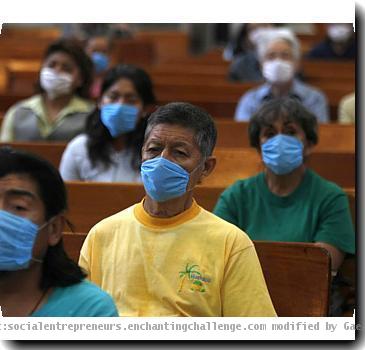Crowded hajj ritual of stoning the devil presents highest risk of swine flu spread
By Hadeel Al-shalchi, APSaturday, November 28, 2009
Hajj devil stoning ritual biggest swine flu risk
MINA, Saudi Arabia — Millions of Muslim pilgrims, many wearing surgical masks, jostled together shoulder-to-shoulder furiously casting pebbles at stone walls representing the devil Saturday — the hajj ritual of highest concern to world health authorities watching for an outbreak of swine flu.
The annual Islamic pilgrimage draws 3 million visitors each year, making it the largest yearly gathering of people in the world and an ideal incubator for the H1N1 flu virus.
So far, only around 60 flu cases have been uncovered, but health officials warn it is likely spreading silently among pilgrims — and the true extent of the push that hajj has given to the virus won’t be known until later, after the faithful have returned to their home countries around the world.
Saudi officials, along with American and international health experts, have geared up here to try to limit any outbreak. But they also are using the pilgrimage as a test case to build a database, watch for mutations and look for lessons on controlling the flu at other large gatherings like the 2010 soccer World Cup in South Africa.
The stoning of the devil ritual, performed on Friday, Saturday and Sunday, is when the crowds of pilgrims at the five-day hajj are at their height and contact between them is closest.
Under a hot sun Saturday, hundreds of thousands of sweaty bodies pressed against each other toward the stoning walls. The majority did not wear masks, and many sneezed, coughed and spat and looked visibly exhausted.
Other parts of the hajj — such as the circling of the Kaaba shrine in Mecca — see a lot of physical contact and close quarters, but perhaps not as much as the rites at Mina, in a desert valley outside Mecca. The epic crowds squeeze together along ramps and platforms that control traffic around the walls. They push past each other to hurl their pebbles at each wall, often shouting curses at Satan and rejecting his temptations.
“This is when the crowding is at its peak and this is where the spreading is likely to take place,” said Hassan el-Bushra, an epidemiologist at the Cairo office of the World Health Organization. “All the hajjis (pilgrims) are in a very limited physical location.”
Like many here, Mikail Ocasio, a 28-year-old pilgrim from Maryland, dismissed the swine flu worries.
“No disease was going to stop me from making my hajj,” he said. “Allah made the call to me and made it available and nothing is going to stop me.”
Mina has long been the most dangerous of hajj rituals because the same overwhelming crowds raise the risk of deadly crushes and trampling. In 2006, more than 360 pilgrims were killed when a piece of dropped luggage in a moving crowd caused a pile-up.
Since then, Saudi authorities expanded the giant ramp around the walls to five stories, spreading out the masses over different levels to prevent jams.
American and Saudi health officials circulated among the sprawling tent camp at Mina where the pilgrims live and gave the faithful cheek swabs for testing later.
Health authorities hung posters of correct hand washing, and hand sanitizer dispensers were placed on walls in the camps, near public bathrooms and at ritual sites. Pilgrims arriving at Saudi airports were also scanned using a thermal camera and were offered a free vaccine.
So far, four pilgrims have died from swine flu since arriving in Saudi Arabia, and 62 others have been diagnosed with the virus after reporting at the hundreds of clinics that have been set up at the holy sites in and around Mecca.
Health officials expressed relief at the low number. But since the flu’s incubation period can be as long as a week, the number of cases from hajj won’t be known until after pilgrims return home, starting Sunday. Then it will be up to their home countries to monitor new cases.
“We don’t expect there to be a big number of cases in the next two days; it will be the week after hajj when you will see the escalation,” said the WHO’s el-Bushra.
Many pilgrims already infected may have such mild symptoms they don’t even know they are infected. Others simply don’t seek treatment.
“A guesstimate of 30 percent of sick people will not come in for treatment because they are afraid of missing some of the rituals,” said Shahul Ebrahim, who is part of a team from the U.S. Centers for Disease Control who are at the hajj helping Saudi health officials deal with swine flu.
Saudi Arabia this year recommended that those highly susceptible to H1N1 — the very young and the very old — stay away this year, and that may have had some impact in limiting cases.
Still, some pilgrims were seen carrying newborn babies and dragging infants behind them as they circled the Kaaba. Many elderly pilgrims feebly slumped in wheelchairs as relatives pushed them through the motions of the rites. For the old in particular, it’s hard to pass on the hajj, since many want to do it at least once in their lifetimes.
World health authorities are concerned about the H1N1 virus because it is a new strain to which the vast majority of the world’s people have no immunity. While it is mostly mild right now, the flu could mutate into a more dangerous form the more it circulates.
The same hajj petri dish that could help the disease spread gives epidemiologists a unique chance to study the virus.
Saudi and CDC experts are working to get cheek swabs from a representative sample of the population for later study. Some pilgrims were swabbed upon entry at the airport and at exit, said Ebrahim. Authorities have also begun taking samples from illegal pilgrims who sneak in by land or sea without hajj visas and have set up sprawling makeshift camps on the rugged mountains of Mina.
The samples will be tested for H1N1 and any new strains of the swine flu that may have developed.
“This data will help with what to do in future mass gatherings, like the World Cup,” Ebrahim said.
Tags: Disease Outbreaks, Islam, Middle East, Mina, Outdoor Recreation, Recreation And Leisure, Saudi Arabia

